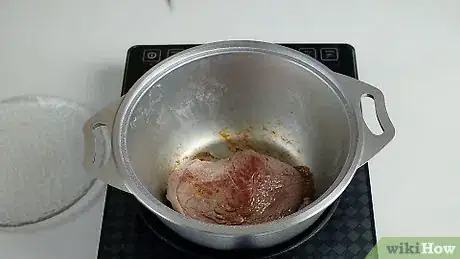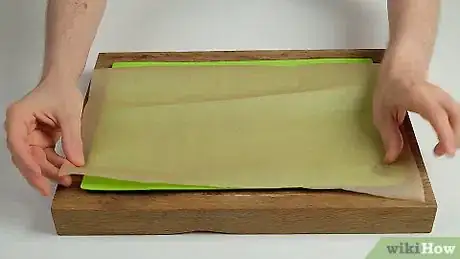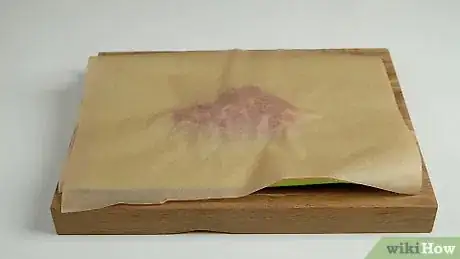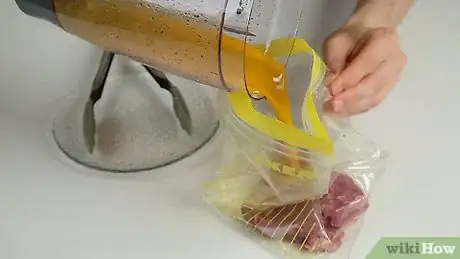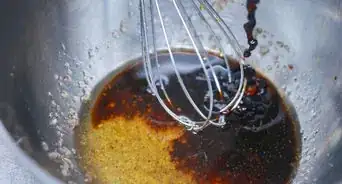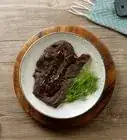This article was co-authored by wikiHow Staff. Our trained team of editors and researchers validate articles for accuracy and comprehensiveness. wikiHow's Content Management Team carefully monitors the work from our editorial staff to ensure that each article is backed by trusted research and meets our high quality standards.
There are 12 references cited in this article, which can be found at the bottom of the page.
The wikiHow Video Team also followed the article's instructions and verified that they work.
This article has been viewed 201,028 times.
Learn more...
Round steak comes from the rear leg of a cow, which makes it quite lean and normally very tough. Because of this, it’s also one of the cheaper cuts of meat, and can be one of the more flavorful ones if you prepare it properly. By knowing a few different ways to break down the fibers in the beef and get it as tender as possible, you can make any round steak taste fantastic.
Ingredients
- 2 pounds (0.91 kg) of round steak
- Salt and pepper to season
- 500 millilitres (17 fl oz) of beef stock, red wine, or water
- 2 pounds (0.91 kg) of round steak
- 1⁄4 cup (59 ml) of oil, such as vegetable or olive oil
- 3 tablespoons (44 ml) of vinegar, such as red wine or apple cider vinegar
- 1 tablespoon (4g) of dried thyme
- 3 cloves of garlic, minced
- 1/4 teaspoon (0.5g) of ground red pepper
- 1/2 teaspoon (2g) of salt
Steps
Braising Round Steak
-
1Sear the steak in a large Dutch oven. Place a Dutch oven over a high heat and add a splash of cooking oil. Once the oil begins to shimmer, add in your round steak and sear it on all sides until golden brown.[1]
You don’t need to cook the meat at this point, you only need to add a crust and some color to the outside. Use a high heat to sear and a lower heat to braise.
-
2Remove the steak and deglaze the pan. Once the steak has browned on all sides, take it out of the pan and set aside. Pour in a little beef stock or red wine, just enough to cover the bottom of the pan, and stir with a wooden spoon. This will deglaze the pan, scraping up any delicious browned bits on the bottom to add to the flavor.[2]
- Red wine, beef stock or even water will work when deglazing a pan. Choose something that you like the taste of. Red wine will add some extra richness, beef stock will complement the flavor of the meat, and water will let you add your own flavors. Try combining different liquids for a more complex flavor.
- If you want to add any vegetables to the meal, you should do so before deglazing the pan. Cut your vegetables into bite-sized pieces and cook them until soft and aromatic. Peppers, mushrooms, onion, and carrot would all make great additions,
Advertisement -
3Add the steak back into the pot and add more liquid. Once the stock or wine has started bubbling slightly and you’ve lifted everything from the bottom of the pan, place the steak back in. Pour in some more beef stock, red wine or water until the steak is around half-covered.[3]
- Add any aromatics you want to infuse with your steak at this point. Bay leaves, orange peel, or garlic could all be great additions.
-
4Bring the liquid to a boil and lower to a simmer. Keep an eye on the steak as the liquid around it heats up and begins to boil. Once it starts boiling, immediately lower the temperature to bring it down to a slight simmer.[4]
- You can also leave your steak to simmer in the oven rather than on the stovetop. Heat your oven to around 350 °F (177 °C), cover the top of your Dutch oven and leave it to cook for around 2 hours.
-
5Cook the round steak for around 2 hours. When the liquid is simmering, cover the steak and leave it to cook until it is tender. Perfectly braised meat should be easily pulled apart with two forks, referred to as being “fork-tender”. Check your steak after around 1 hour to see if it is cooked.[5]
- The time it takes to cook your round steak will vary based on the cut and how thick it is. After the first hour, check your steak every 30 minutes or so until it is done.
-
6Remove the meat from the liquid and serve. Use a pair of tongs or a wooden spoon to lift the meat out of the Dutch oven and onto a serving plate. Serve the steak immediately with fresh vegetables and mashed potato.[6]
- For extra flavor, reduce the cooking liquid down further to turn it into a delicious sauce that can accompany your steak. Cook it over a high temperature until the sauce reduces, or add cornstarch to thicken it to your desired consistency.
Tenderizing Using Force
-
1Cover a flat surface with parchment paper. Tear off a sheet of parchment paper slightly bigger than your round steak. Lay it out over a wooden cutting board or over a flat work surface. This will prevent the steak from sticking to anything as you tenderize it.[7]
- Instead of parchment paper, you could also use clingfilm or a clean plastic bag to cover your steak. Anything that will prevent the meat from directly touching another surface and that can be removed easily will work great.
-
2Lay your steak down and cover it. Take your round steak out of the packaging and lay it down on your parchment paper. Cover the steak with another piece of paper or clingfilm so that it is securely covered on both sides.[8]
-
3Pound the meat to tenderize it. Using a meat mallet, begin evenly tapping across the surface of the meat with the spiked side of the mallet. Apply a firm pressure and work all over the steak, flattening and breaking up the fibers rather than damaging it.[9]
- If you don’t have a meat mallet or tenderizer, you can use a flat skillet, a rolling pin, or even a sturdy roll of tin foil.
- You don't need to completely flatten your steak or spend a long time tenderizing it. Start at one end of the steak and slowly work down to the other end, hitting all parts of the meat with the mallet. Work back up the steak once more to make it tender without overworking it.
-
4Remove the paper and cook your steak. Peel away the top layer of parchment paper from the round steak, being careful not to leave any paper behind. Lift the steak off of the bottom piece of paper and place it into a hot frying pan, skillet or griddle to cook.[10]
- As you have tenderized the meat and slightly flattened it in the process, the steak shouldn’t take long to cook. Give it 2-3 minutes on either side, keeping a close eye on it as it cooks.
Salting Steak to Tenderize It
-
1Cover one side of your steak with kosher salt. Place the round steak on a plate with a rim around the edge and begin liberally shaking salt onto the surface. Cover the steak with a layer of salt that is just thick enough so you cannot see the meat.[11]
- Use a coarse salt, such as kosher or a coarse sea salt to salt your steak. Table salt or something similar will be more difficult to remove from the steak and will make your steak too salty.
-
2Press the salt into the surface of the steak. Using one hand or the back of a spoon, start lightly rubbing the salt into the steak. You shouldn’t be using the coarseness of the salt to tenderize the meat, only making sure that all parts of the steak are touching some salt.[12]
- The salt will draw out some of the moisture in the steak, concentrating the flavor of the meat and curing it slightly before you cook it.[13]
-
3Flip the steak over and repeat on the other side. In order to get the most flavor and tenderness from the meat, you should salt both sides of your steak. Lift the steak up and turn it over to salt the other side, being careful not to rub off too much of the salt that is already there.
-
4Store the steak in the fridge for around 1 hour per inch (2.5cm) of thickness. Place the salted steak in the refrigerator to let the salt begin tenderizing the meat. As a rough guide, you should let the steak sit for roughly 1 hour per inch of thickness of the steak. If it’s 1 1⁄4 inches (3.2 cm) thick, for example, leave the steak for around 1 hour and 15 minutes.[14]
- Don’t let the steak sit for too much longer than it needs to. If you leave it for too long, you may cure your steak rather than tenderizing it, which will change the texture.
-
5Scrape away the salt and cook your steak. After the salted steak has been left to sit, use a butter knife or something similar to scrape away as much salt as you can. Rinse the steak under some cold water to wash away any remaining salt and pat it completely dry with a few paper towels. Cook your steak in a skillet, frying pan, or griddle over a medium-high heat for 4-5 minutes on each side.[15]
- When seasoning your steak, you shouldn’t add any more salt. There will be enough salt residue on the steak to flavor it and any extra may leave you with a very salty steak.
Using a Tenderizing Marinade
-
1Pour 1⁄4 cup (59 ml) of oil into a blender. This will make the base of the marinade, so use whichever type of oil you like the taste of. Olive oil is a great choice, but vegetable, peanut, or canola oil will all work as well. Add 1⁄4 cup (59 ml) of the oil to the jug of a blender.[16]
- If you don’t have a blender, you can make your marinade in a small bowl. Make sure you cut all of your ingredients very finely and mix them together well.
-
2Add 3 to 4 tablespoons (45-60ml) of vinegar. The acidity of the vinegar will help break down the steak to make it more tender. Red wine vinegar will complement the meat well, but you could also use apple cider or white vinegar if you prefer. Add 3 tablespoons (45ml) of vinegar to the oil, or 4 tablespoons (60ml) if you want a stronger marinade.
- The most important part of the vinegar in this context is its acidity, so you can use anything acidic in its place. The juice of a lemon or lime could also work fantastically and provide a slightly fresher flavor.
-
3Mix in any herbs and spices you like. With the base of the marinade made, you can add in whichever other flavors you want. Try adding in 1/2 teaspoon (2g) of salt, 1 tablespoon (4g) of dried thyme, 3 cloves of peeled garlic, and 1/4 teaspoon (0.5g) of ground red pepper for a simple yet delicious marinade.
- If you are using a blender, you don’t need to cut up the herbs or garlic as they will be finely chopped as the marinade is blended. If you are working by hand, mince the garlic and chop any herbs you want to add very finely.
- The flavors you add to your marinade are entirely up to you. Garlic, rosemary, thyme, paprika, and red pepper will all go great with a classic steak. See what other flavor combinations you can come up with!
-
4Blend your marinade until it is fully combined. Put the lid on the blender and turn it on to a high speed for around a minute. Keep processing it until any herbs are finely chopped and the vinegar and oil emulsify slightly to combine. Pulse the blender once or twice more once it's done to catch any herbs that haven’t been cut fully.[17]
-
5Place your steak and marinade in a zip-lock bag. Transfer your meat into a fitting zip-lock bag and carefully pour over your prepared marinade. Seal the bag firmly and use your hands to massage the steak slightly, so as to make sure the marinade is covering all of the meat.[18]
- If you do not have or don’t want to use a zip-lock bag, you can put your steak in a small bowl and cover it with the marinade. You may need to turn the steak over as you let it marinate to make sure all sides are evenly coated.
-
6Let the round steak marinate for at least 2 hours in the fridge. Put the zip-lock bag with your marinade and steak into the refrigerator for at least two hours to begin marinating. The acid in the vinegar will start eating into the meat, breaking it down and tenderizing it while adding more flavor.[19]
- You can leave your steak in the marinade for longer to give it more flavor. However, if left too long, the acid will break down the steak too much and ruin the structure of it. Don’t leave the steak marinating for more than 6 hours.
-
7Take your steak out of the marinade and cook it. Remove the zip-lock bag from the fridge and let the steak come up to room temperature. Lift the steak out of the marinade and cook it on a skillet, frying pan, or griddle over a medium-high heat for around 5 minutes on either side.
- Once you are done with the marinade, you should immediately dispose of it. Seal the ziplock bag and throw it away.
Warnings
- Always be careful when working with high heat.⧼thumbs_response⧽
Things You’ll Need
Tenderizing Using Force
- Parchment paper or plastic wrap
- Meat mallet
Salting Steak to Tenderize It
- Rimmed plate
Using a Marinade
- Blender or mixing bowl
- Zip-lock bag or bowl
Braising Round Steak
- Dutch oven
- Wooden spoon
References
- ↑ https://www.foodnetwork.com/how-to/articles/how-to-braise-meats-a-step-by-step-guide
- ↑ https://www.bonappetit.com/test-kitchen/cooking-tips/article/how-to-braise
- ↑ https://www.foodnetwork.com/how-to/articles/how-to-braise-meats-a-step-by-step-guide
- ↑ https://www.foodnetwork.com/how-to/articles/how-to-braise-meats-a-step-by-step-guide
- ↑ https://www.allrecipes.com/recipe/152453/president-fords-braised-eye-round-steak/
- ↑ https://www.bonappetit.com/test-kitchen/cooking-tips/article/how-to-braise
- ↑ https://youtu.be/Fmn495n90rs?t=29
- ↑ https://youtu.be/Fmn495n90rs?t=29
- ↑ https://youtu.be/Fmn495n90rs?t=37
- ↑ https://youtu.be/Fmn495n90rs?t=83
- ↑ https://youtu.be/ai-A9GX4lrA?t=36
- ↑ https://youtu.be/ai-A9GX4lrA?t=63
- ↑ https://www.tasteofhome.com/article/how-to-make-tough-meat-tender/
- ↑ https://youtu.be/ai-A9GX4lrA?t=68
- ↑ https://youtu.be/ai-A9GX4lrA?t=104
- ↑ https://www.tasteofhome.com/recipes/all-purpose-marinade/
- ↑ https://www.tasteofhome.com/recipes/all-purpose-marinade/
- ↑ https://www.tasteofhome.com/recipes/all-purpose-marinade/
- ↑ https://www.tasteofhome.com/article/how-to-make-tough-meat-tender/
